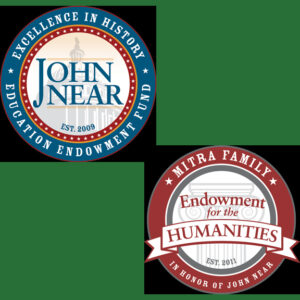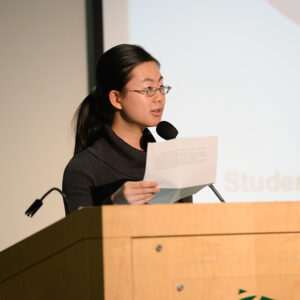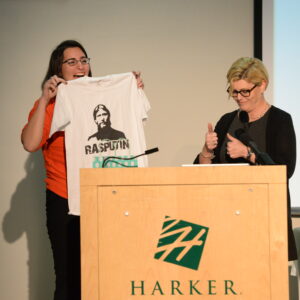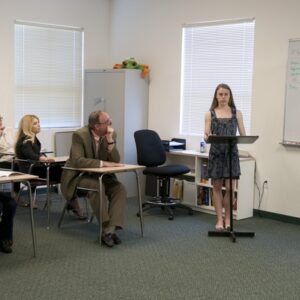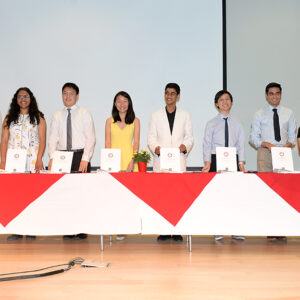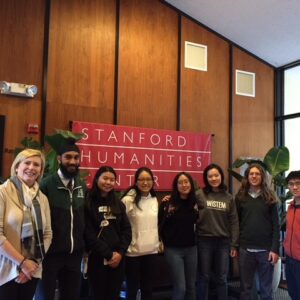Eight more students walk away from Harker this year, each having contributed a unique historical research paper to the growing archive housed in the John Near Research Center.
Harker’s two grant programs, The John Near Excellence in History Education Endowment Fund, founded in 2009, and the Mitra Family Endowment for the Humanities, founded in 2012, funded the students’ yearlong efforts. The range of papers for 2013-14 is remarkable. From an analysis of the viability of bitcoins to counter-intelligence efforts against the Black Panthers to the influence of the Roman Republic on the Constitution, each topic was plumbed by a student intrigued by its roots. At the annual reception in late April for Near and Mitra scholars, students and mentors spoke about the long road to complete a research paper and what they discovered about themselves and their topics, along the way.
Four of the papers address societal problems in the U.S. Connie Li, one of the five Near grant recipients, followed her muse to write “Islamic Student Experience in the Classroom after 9/11: A Holistic Analysis of Sociopolitical Influence on the Muslim Student Pysche,” finding that the most commonly used textbooks in U.S. schools use one-sided descriptions of Muslims; while Muslims find themselves discriminated against, there are Muslim voices that rise to protest being victimized and other voices that protest the demonization of Muslims.
The subject matter is of interest to every thinking American as it is one of the great polarizing topics of our time. Her three-plus page bibliography is impressive. “I’ve been devoted to understanding American identities under siege because religion is something so precious to identity, but so difficult to share peacefully, sometimes, that I have learned to measure the achievement of the American ideal of liberty against the progress and protection of religious freedom,” said Li. “My work is about reaching beyond the easy judgments, the sweeping generalizations and the self-defense of hate that is so easy to wrap around ourselves in times of both fear and comfort.”
In researching her topic, Divya Kaladindi selected a topic of great interest, as it is germane to our NSA-surveilled world. Kaladindi scrutinized the FBI’s famed 1960s Counter Intelligence Program (CoIntelPro), a counter-terrorism campaign bent on destroying groups identified as subversive in her paper, titled “Watching and Wiretapping: An Analysis of the Implications of the FBI’s Illegal Counter-Intelligence Programs against the Black Panther Party during the 1960s.” She focused on their penetration and destruction of the Black Panther movement, which included trashing their Chicago headquarters after contriving an excuse to search the premises.
Luckily, the program was exposed and, though the Black Panther Party was destroyed, the FBI came under such scrutiny it was forced to disband CoIntelPro, and regulations were put in place to prevent a similar effort from reoccurring. Kaladindi has successfully encapsulated a piece of political history in such a way that both ends of her chain, the pernicious facets of the FBI and the radicalism of the Black Panthers, stimulate tangential consideration. “I chose this topic mainly because of a strange fascination with the FBI,” she said.
Through her research, she found that, “The FBI was, in fact, just as interesting and scandalous as it appeared to be in popular culture but inherently much more complex. Guidelines, propriety and issues of legality fell to the sidelines as spying, forgery, harassment and psychological warfare reigned in desperate attempts to quash militant groups like the Panthers. This process was extremely demanding, but through it I learned the importance of time management and critical thinking. I’m probably on the FBI’s radar because I’ve visited their site so many times,” she noted.
One of the most original papers yet submitted was that by Monica Thurkal, who examined how curly hair has influenced the treatment of individuals in life and literature in her paper, “Wanton Ringlets: A Tangible Medium for Identity and Power.” Thurkal noted that she has straightened her hair for years, and that effort led her to question the value of conforming in order to fit in professionally, and how hair-straightening can affect a woman’s self-confidence. She addresses the cultural tendency of some ethnicities to straighten hair in order to become more mainstream, and how negative attitudes in literature towards kinky hair promote stereotypes and pigeonhole its wearers.
Wanton Ringlets is a phrase describing Eve from Milton’s “Paradise Lost,” and Thurkal notes it pins Eve with connotation of immorality. In her paper, Thurkal notes a number of legal precedents that appear to punish those with non-straight hair. Her paper is an interesting perspective on an unusual topic. “Through my project, I learned that hair is really a symbol of social oppression,” said Thurkal. “Why do popular teen movies or popular culture associate straight hair with womanhood, and why is straight hair an expectation for professional appearance within the business world? By changing their hair, women experience a troubling rejection of themselves. What was really cool was that I was able to create my own intellectual path within the subject of sociology,” she said.
This subject, though not at the forefront of social recognition, gives pause to those who have never considered the ramifications of hair. Thurkal has taken an uncomfortable reality and written about it thoughtfully and with insight that makes it relevant, no matter who you are.
Finally in the social consciousness collection, Zina Jawadi examines the disability rights movement in her paper, “The Hidden History of the Disability Rights Movement: Improving Access to Education in the Shadow of the Feminist and Civil Rights Movements of the 1960s and 1970s.” Jawadi, a tireless advocate for disability rights, noted that the movement is under-researched, though, promisingly, there has been a thousandfold increase in journal titles on the subject from 1979 to 2011. She notes that 50 years ago, as marginalized populations stood up to be recognized, the atmosphere created by the larger student movements, especially on college campuses, allowed disability rights efforts to be heard both due to entrenched powers being forced to examine their policies on civil and women’s rights and thus hearing about disabled persons’ needs, and because disabled rights workers were able to learn from observing successes of those managing other rights movements.
This is a paper filled with the passion of its writer and it is a must-read for anyone interested in human rights. “Initially, I expected my research to confirm my hypothesis that these social advocates supported each other, thereby strengthening all of the movements,” Jawadi said. “How wrong I was. My research gave me a greater understanding of what was going on behind the scenes,” and Jawadi noted there was often competition for media attention.
Jawadi, who has a significant hearing loss, said that ever since eighth grade, she has worked towards her lifetime goal to change the world of hearing, scientifically and socially.
Her work on the Near paper “helped me crystallize my calling,” she said. “A children’s advocate started a fund in 1973 hoping to provide children with disabilities better access to education. She was disgusted to discover from the U.S. Census Bureau that 750,000 children with disabilities, aged seven to thirteen, were not attending school. These children were hindered from receiving proper education because of their disabilities.”
“My research gave me a deeper perspective on the struggle people with disabilities face and, based on my research, I have developed a three-step plan for my disability rights work. I hope to witness a second disabilities rights movement.”
In a long step from disability rights, the paper “Bit by Bit: An Economic Analysis of Bitcoin’s Viability as a Currency,” by Anisha Padwekar, retails the growth of bitcoins, their advantages and disadvantages. Her paper is a well-researched, well-ordered contemporary analysis including relevant history, and is a great primer for anyone interested in the phenom of bitcoins.
While most readers are familiar with the term, and understand the protocurrency is digital, few grasp the technology behind it and the value – or the dangers – of the digital currency plan. Padwekar takes what could be a very dry subject and, using historical comparisons, news items on bitcoin and financial market analysis, defines for readers why bitcoins are attractive and yet not quite ready for prime time; she makes the topic not only readable, but interesting. “I wanted to choose a topic that would be a relevant economic question today,” said Padwekar. “Perhaps the most interesting part of my research were the tangents I went on. It was interesting to read about regional alternative currencies. While validating my interest in economics, the project helped me discover my interest in cryptography.”
In her paper, Padwekar notes how entrenched financial organizations, such as national banks, have yet to define bitcoins officially as currency, thus avoiding dealing with the many unresolved issues of money that is a string of numbers and not even nominally backed up by specie. Although Padwekar noted that for various reasons bitcoin will probably fail, interest in the subject remains high as digital currency seems like a predictable step in the development of our digital society. Recommended reading for anyone who would like to be able to contribute to the conversation next time the subject comes up!
Harker News has included Angela Ma’s accomplishments as a ballerina in a number of stories, and Ma has now taken her taken her passion from the stage to the library with her analysis, “The Role of Musicianship in George Balanchine’s Enduring Impact on American Contemporary Ballet.” Ma tracks the seminal choreographer as he learned to dance, play, compose and choreograph in his native Russia. So many talents packed into a single person is daunting, and Ma traces his growth through his other talents to that of the ultimate choreographer, despite Balanchine’s assertion that composing, not choreography, earned the “highest seats in heaven.”
Ma’s closely written analysis goes a long way toward explaining the complex relationship between a composition and how a choreographer translates that into dance. She mentions few specifics, but uses great illustrative anecdotes and quotes tell the story of how Balanchine thought, thus choreographed. Though the paper discusses the technical nature of composition, Ma brings forth the passion Balanchine felt in his four-decade collaboration with Igor Stravinsky and illustrates to readers how the partnership between the two men resulted in Balanchine’s timeless choreography.
“I initially chose this topic because dance has been such an irreplaceable and meaningful part of my life,” said Ma. “I wanted to explore ballet in a new way beyond the studio.” Looking back on the process, Ma noted that her mentors helped her to “learn so much about dance and intellectualism.” Ma illustrates the impact of dance, style and the depth that Balanchine brought to ballet, noting that in “Tchaikovsky Pas de Deux” he “complements the musical tempo and varying succession of notes with a customized dynamism of movement.”
The only paper that looked outside of the United States for subject matter addressed the similarities and differences between two modern revolutions, those in Poland and Tunisia. As with most revolutions, each government had to wear out its welcome – leaving the population without hope for improvement – before the citizenry pushed back and created such a groundswell of opposition that the governments threw in the towel rather than bring warfare into the picture to repress the revolution. But each kicked off a string of political upheavals in their greater geographical regions and the repercussions from each continue today in both regions.
Maya Madhavan wrote “A comparison of the Causes of the 1989 Collapse of Communism in Poland and the 2010 Jasmine Revolution in Tunisia,” and points out the differences between the populations’ education levels as being one of the determining factors in the instigation of each revolution, while both revolutionary groups shared economic distress. Tunisia’s jobs went to the well-connected and the younger generation saw their college educations going to waste while Poles of all ages suffered reverse after reverse under Communist rule. It goes almost without saying that oppression and corruption flourished in both countries.
Madhavan compared and contrasted the political atmospheres and used an accepted model of revolutions as a template to explain the differences. This paper tells the story of not just these two countries, but of the revolutions that shattered the Soviet Union and revolutions that took place in the Mideast over the last few years. We have not seen the end of conflict in either region, and this paper helps to bring clarity to the reasons these peoples stood tall for freedom.
“What surprised me the most was not their similarities, but their differences,” said Madhavan. “I went into this expecting to see a number of parallels between the two – you could say I overestimated the extent to which I thought history repeats itself. I don’t think I realized just how much the world has changed in the past 20 years, and never really understood the impact that recent technological advantages have had on the dynamics of our world.”
The last paper of the group was both the longest and reaches back the farthest in history, as it deals directly with the U.S. Constitution, its framers and its antecedents. Kevin Duraiswamy wrote “Ancients Alive: The Influence of the Roman Republic on James Madison’s Conception of the Senate and the Resulting Impact on the American Constitution” to illustrate how Madison’s classical education, in sync with other classically educated framers, led to a Constitution and legislative arrangements that have held up for nearly 240 years, with no serious threat to either in sight.
“For a long time,” Duraiswamy said, “my main academic interests have been the founding of America, the Constitution, and the classics, so my topic provided a nice opportunity for me to explore an intersection of these three subjects.”
Duraiswamy noted how Madison fought for not only a bi-cameral legislature, but for two different types of bodies to both represent the people’s stated wishes and to provide a check on those wishes when, motivated by some popular event, they conflicted with sensible progress. While many will have learned of the classical education given to those who could afford it in this country’s formative years, few of us consider what that education meant in terms of framing a document that would withstand challenge after challenge.
This is a paper that opens the door to as many questions as it answer. “The hardest part of the process for me was probably narrowing the focus of my topic,” said Duraiswamy. “In other words, using the greater length of the paper to add depth to my research rather than breadth. Initially, I thought I would explore the Roman influences on the entirety of Madison’s political thought, but after talking to my mentors, I realized that that was not narrow enough.
“If I tried to cover everything, my analysis would not be able to explore the intricacies of his ideas and would not be able to delve into primary sources as much. Instead, it would be better to pick one aspect of Madison’s philosophy and study its classical antecedents. Eventually, I settled upon the idea of the Senate within Madison’s political ideology, but it took me a significant amount of time and effort to get to that point since I had to explore many of his ideas to see which one had the most potential for my topic.”
The thoughtful reader need only reflect on the disarray that occurs in various foreign congresses to see the value in separating those elected as direct representatives of their constituents’ geographical and local political interests, and those that are charged with the task of doing what is right for the nation on a macro level. This was a most enlightening paper and will be relished by anyone interested in ancient and modern history.
Next year’s 2014-15 Near Scholars are Ayush Midha, Karnika Pombra, Apoorva Rangan, Vedant Thyagaraj and Felix Wu; the 2014-15 Mitra Scholars are Aadyot Bhatnagar, Maya Nandakumar, Agata Sorotokin and Stanley Xie.
Since the first grants were made in 2010, 21 original papers have been archived for reference in the John Near Resource Center. All papers are available on the Harker library website. Topics have included “Winston Churchill’s Efforts to Unify Britain From 1940-1941,” “Can Charter Schools Close the Achievement Gap?,” “Arleigh Burke’s Submarine-Based Finite Deterrent: Alternative to the Nuclear Triad,” to name just a few.
Each year, a number of students are selected from applicants to receive the grants and, each year, the completed papers are read, celebrated and archived as part of Harker’s legacy, honoring both donor families for their timeless contribution to both historical research and the intellectual growth of Harker students.
The John Near Excellence in History Education Endowment Fund was established in memory of the 31-year veteran of Harker’s teaching staff, who passed away in 2009. Donors of the $300,000 endowment are James and Patricia Near, John’s parents, and in John’s own words, the proceeds will be used “to help develop the history department, both through the acquisition of resources and providing growth opportunities for both faculty and students.”
The Mitra Family Endowment for the Humanities was established by Samir and Sundari Mitra.“The subject matters taught under humanities such as history, languages, communications and philosophy are critical skills and knowledge that develop well-rounded Harker students,” said Samir Mitra. “Humanities is the bedrock of a superior education and will enable our students to stand out as recognized contributors in their future professions.”





